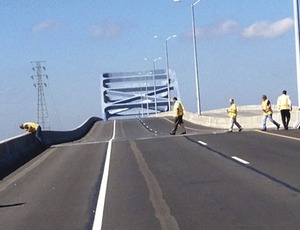

The Leo Frigo Memorial Bridge on Interstate 43 in Green Bay, Wis., is closed indefinitely after a pier settled early on Sept. 25, causing a more than 20-in. sag across the four-lane roadway.
State and federal structural and geotechnical experts have been joined by consultants from Michael Baker Jr. Inc. and Wiss, Janney, Elstner Associates Inc. to examine the bridge and develop a plan of action.
No one has determined the cause of the settling, any estimated time for repairs or any cost for repairs. The depression is 22 in. on one side and 27 in. on the other side of the 80-ft-wide bridge.
John Luczaj, professor and geosciences chairman at the University of Wisconsin-Green Bay, has studied the geology of the county and, based on the data available, believes the 100-ft H-pilings under Pier No. 22, the one that settled, are not deep enough to reach bedrock. His studies show bedrock near that site to be 123 ft to 150 ft below ground level.
Kim Rudat, spokesman for the Wisconsin Dept. of Transportation, could not provide a specific measure for the H-pilings in relation to bedrock but said they are "no more than 20 ft" above bedrock.
Luczaj also pointed out as a possible factor the area's multiple deep aquifers, which were drained by pumping but now are refilling since pumping was banned in 2007. "That [water] level was below the top of the bedrock when the bridge was built but now has fluid pressure pushing up on it from below," Luczaj said. Water seeping into the clay between layers of sand changes the friction level of the clay, he said.
Contributing Factors?
Other possible contributing factors include a large landfill south of the bridge that could have exerted pressure from its weight along with a long-existing water flue north of the bridge. In addition, there were vibrations in the area during the 15 months and $17 million worth of maintenance work on the bridge. That project, which was completed in July, included repairing three bridges and building a deck overlay to replace deteriorating pavement.
The state-federal-private team is measuring the bridge for further motion and looking at Pier 22 as well as the adjacent Piers 21 and 23.
The double hammerhead piers have two shafts supported on footings with a strut between the footings, according to Bill Dreher, the DOT's structures design chief. The piers are 82 ft high and the footings are 8 ft deep.







Post a comment to this article
Report Abusive Comment